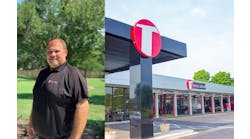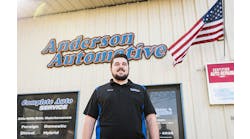Imagine being able to hop on your computer every morning and, with the click of a button, instantly see how your marketing efforts are doing against your competitors—or you could assign personas to customers to narrow down your target customer, create campaigns so various marketing tools work together toward a common goal, or see the number of website visitors who are actively engaging with your shop.
For Bill DeBoer, that scenario used to seem virtually impossible.
Since helping the family business transition into mechanical work in 1997, DeBoer, now the owner of DeBoer’s Auto Sales & Service in Hamburg, N.J., struggled to get the word out about the small, three-bay repair shop.
DeBoer’s Auto Sales & Service had built its early reputation as a used car dealership. And entering the repair segment, DeBoer stuck with the same marketing strategies: newspaper, TV, radio and billboard ads.
Fast-forward 15 years, and not much had changed. That traditional marketing strategy had helped the mechanical shop gain solid footing—at least, that’s what DeBoer assumed—but those ads were starting to get costly, and he had no tangible way of tracking their success.
That’s when DeBoer decided he needed to embrace a different philosophy of marketing that would not only reduce his costs, but also create a web presence for the small shop that rivals that of a larger business.
THE BACKSTORY
Founded in 1982 as a used car dealership, DeBoer’s father, Bill Sr., grew the business until DeBoer came on board in the early 1990s. At the time, the business was doing repairs on the used cars in its lot but no outside work. DeBoer saw an opportunity and decided to tackle the auto repair side of the business, receiving his automotive technology certification before earning his Bachelor’s degree in business management from Penn State.
DeBoer then joined the shop full time in 1997 and over time, helped grow the five-person repair shop to $500,000 per year in total sales, which represents 40 percent of the business.
THE PROBLEM
When DeBoer originally joined the business, the Internet was still nascent. Because of that, DeBoer followed the traditional outbound marketing strategies; newspaper, cable TV and radio ads were the crux of his shop’s marketing.
Then in 2008, the recession hit. For a small business like DeBoer’s, the impact was significant and he stopped virtually all marketing during the recession as a way to save money. The business survived the uneasy time but as the economy started to recover, growth was still stagnant for the shop in 2013.
DeBoer knew that in order to grow sales, he would need to jumpstart his marketing efforts again, but he also knew that if he stuck to the same marketing tactics he was using pre-recession, he would end up in the same boat.
“I never really had huge budgets to work with because we’re a small dealership, and it’s tough to compete with the outbound stuff,” he says. “We didn’t know how many people were looking at our website, if we were actually slow, whether we didn’t have what people were looking for.”
DeBoer wanted a marketing plan that would allow him to more closely track his efforts and nurture more leads that would hopefully lead to more sales. And he wanted to do it in a way that didn’t drive up costs and force him to compete with larger businesses.
DEBOER’S AUTO
LOCATION: Hamburg, N.J.
SIZE: 3,000 square feet
STAFF: 5 (2 technicians, 1 owner, 1 assistant manager and 1 receptionist)
NUMBER OF LIFTS: 3
AVERAGE MONTHLY CAR COUNT: 190
ANNUAL REVENUE: $500,000
THE SOLUTION
With that in mind, DeBoer—an avid reader—decided to read everything he could about marketing and see what stuck out to him or seemed doable for the shop. Through that reading, he was introduced to the concept of inbound marketing.
“Inbound marketing is more of attracting people to you by providing information via blog content, video content and social media content so you can get found in an organic way that brings them to your website, Facebook page, etc., where they want to discover more of who you are,” DeBoer says. “It’s about cutting yourself out in the industry as an expert in your field and attracting people to you versus trying to outspend your competitor on TV, radio, especially because those mediums are so interrupted right now.”
DeBoer started by refreshing his website and adding more landing pages to drive customers to information more specifically related to their inquiries. Then, he turned his focus to producing content. He blogs six times a month, posts on Facebook, Google+ and Twitter at least three times per day, posts regularly on Instagram and Pinterest, writes and monitors Instagram and Facebook ads, sends email newsletters and writes downloadable e-books, which takes him roughly a month to complete. While that may seem exhaustive, DeBoer is able to create and monitor all of those efforts through his online marketing platform, HubSpot. HubSpot is an inbound marketing platform that allows users to create and publish content, track results and roll content into campaigns that act together to drive and nurture leads. All of the DeBoers efforts act together.
For example, if he’s looking to increase tire sales, he will create blog posts and an e-book on the topic (such as “The Four- Step Process to Tire Shopping”). Next, he will create Instagram and Facebook ads to generate clicks on the posts or download the e-book. Those e-books and Facebook ads will have “call-toaction” buttons that DeBoer has created to capture customer information, which he will then use to send a follow-up email or newsletter. That’s called “lead nurturing,” he says, and it’s a way to continue building a relationship with the customer in hopes of eventually capturing a sale.
Using HubSpot, he can easily see how the posts, ads or calls to action are doing, how many people are clicking on the links and how many are converting into potential clients.
“You can measure your marketing performance,” he says. “You can see how many visits you had this month versus last month, how many contacts this month versus last, how many customers.”
DEBOER’S TOP INBOUND MARKETING BOOK PICKS
Before starting on inbound marketing, DeBoer went to the top experts on the topic and read numerous books on the philosophy. Those books include:
• Invasion of the Profit Snatchers, Jimmy Vee and Travis Miller
• Duct Tape Marketing, John Jantsch
• Jab Jab Jab Right Hook, Gary Vaynerchuk
• Inbound and Content Marketing Made Easy, Marcus Sheridan
• Getting Noticed in a Noisy World, Michael Hyatt
DeBoer has also customized the system for his own use so that he can seamlessly pre-schedule all posts, use a Google Chrome plug-in to more easily post to social media and group posts together in campaigns centered on a theme for easier tracking. In fact, he says he’s simplified it so much that he only has to spend 30 minutes per day in the system, 15 minutes in the morning and another 15 at night.
Although he has worked with a marketing firm since 2014 that handles the design and back-end mechanics of the website, DeBoer says he enjoys being hands-on and tries to create and post as much content as he can.
THE AFTERMATH
“Our Internet activity has gone way up,” says DeBoer. That’s putting it lightly. Since switching over to an inbound marketing philosophy in 2014, DeBoer’s website visitors increased 70 percent, leads increased by 200 percent and the number of users who downloaded an asset (such as an e-book or viewed the inventory) also doubled.
“I was blown away by the amount of traffic we got,” he says. “We’ve grown about 10 percent and the flip side, is that it’s lowered our advertising costs.”
What that means for the business overall is a 20 percent increase in gross sales from 2014 to 2015, the first time the business had grown so significantly since the recession.
Although DeBoer still uses some traditional forms of marketing, including direct mail, he says his new marketing efforts have been key in not only reducing his advertising budget but also growing year over year in revenue. Part of the inbound philosophy, DeBoer says, is to find the least expensive methods that yield the biggest returns. That’s why he started doing Facebook ads over a year ago, when he was still able to get ads for very few cents per click. As that method of advertising has become more popular, he’s moved to the recently launched Instagram ad campaigns, where one click can still cost as little as 8 cents.
“The idea is that as a small business with a small budget, if we can get to these platforms first and quickest when they’re cheap and as they mature, we move on to the next emerging platform,” DeBoer says. “The cheaper the social media network I can get on and make some noise in and get some traction from.”
THE TAKEAWAY
More than anything, DeBoer says the takeaway has been a firmer grasp on his marketing. He understands what’s working—and conversely, what isn’t—and he’s able to experiment more freely with new ideas or forms of marketing because he can so easily monitor and track the results.
Plus, DeBoer says that the content he’s generating now will continue to pay dividends in the future.
“I’m building out digital assets on the Internet for myself,” he says. “I can spend $300 blogging or $300 on a newspaper ad. The difference is that next month, I still have $300 worth of blog material out there. With the newspaper ad, the money is gone. As I build out these digital assets, they just pay dividends on top of each other. That stuff is evergreen content, it’s always going to help people be found by us. It’s like building out real estate on the internet for myself.”



